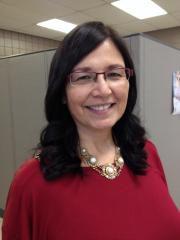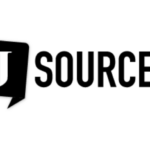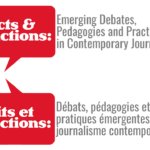“As a journalist, you’re not a juror.” Betty Ann Adam on court reporting
The StarPhoenix reporter on 10 years of covering murder trials and court inquiries.
[[{“fid”:”4059″,”view_mode”:”default”,”fields”:{“format”:”default”,”field_file_image_alt_text[und][0][value]”:””,”field_file_image_title_text[und][0][value]”:””},”type”:”media”,”link_text”:null,”attributes”:{“height”:”240″,”width”:”180″,”style”:”width: 180px; height: 240px; float: right; margin-left: 10px; margin-right: 10px;”,”class”:”media-element file-default”}}]]By Victoria Dinh
When Betty Ann Adam was laid off from Saskatchewan Indian Magazine after it lost its federal funding in 1989, she took a chance. She opted out of completing a university degree, met with Saskatoon’s StarPhoenix then-editor Bill Peterson, and took a job as a reporter at the newspaper that same year.
Indigenous representation in the media was scarce during this time. Though Adam knew she was hired because of her First Nations background, she didn’t want to be pigeonholed as the resident Aboriginal journalist. She found her niche in the newspaper’s court beat after covering general assignments, health and education for about 10 years. Adam continued to report on judicial matters for the StarPhoenix over the next 10 years, becoming nationally recognized for her groundbreaking coverage of the 2003–2004 inquiry into Neil Stonechild’s death.
J-Source: Do you notice a lack of Aboriginal representation in the media when you first started out in the industry?
Adam: Absolutely. There was one time when [my editor] had me participate in a survey conducted by the Editors’ Association of Canada. When the survey results came out, of the newspapers that responded to the survey, I represented 25 per cent of the Aboriginal reporters in Canada. [That meant that] there were four people of Aboriginal descent that were working in mainstream newspapers at the time. That would have been about 1990.
J-Source: What’s the most interesting story that you’ve covered?
Adam: The David Milgaard inquiry. I covered every day of that. That took a lot of my time and I was immersed in it for a long time. It was a horrific story of wrongful conviction with many coincidences and mistakes that were made that lead to this man spending 23 years in prison for a murder that he didn’t commit.
J-Source: What about the inquiry into Neil Stonechild’s death?
Adam: As a reporter, you keep things at a distance emotionally; you keep a professional distance. Yet, you couldn’t help but be moved by what happened there. That was a really important story for me to work on. It’s not that I wasn’t aware of that sort of thing but it really, really felt close to home for me.
J-Source: Were you assigned to cover the inquiry into Neil Stonechild’s death when it was going on?
Adam: When it first started, one of our reporters had spoken to Stonechild’s mother. It was another 10 years before a re-examination of [Stonechild’s death]. At that point, there were a lot of reporters that were involved with the investigative work.
By the time the judicial inquiry began in 2003, I was the court reporter. I covered the Queen’s Bench and provincial court. It was just natural that when the inquiry was called into Neil Stonechild’s death—it was in my beat and so I did it.
J-Source: What was the most challenging part?
Adam: The challenge every day was to take a snapshot of the most important and interesting evidence. You have to assume that this story might be read by someone who doesn’t know anything about [the inquiry] at all, and so your story has to have the new information right off the top and then it has to have background for those people to catch them up. You then have to put this new information into the context of the new evidence that is coming out.
[node:related]J-Source: Did you find yourself developing you own opinion about who was right?
Adam: You can certainly develop an informed opinion. When you listen to evidence, whether it’s at an inquiry or a trial, you can imagine yourself as a juror and think, “How much of this do I believe?” But as a journalist, you’re not a juror. Your role as a reporter is to provide as much information as you can to show balance. Your first job is to be fair and to provide information for all views so the readers can decide for themselves what they believe.
J-Source: It’s a tough subject to be unbiased on. Did you ever get any criticisms for the way that you were covering the inquiry?
Adam: You have to hear the criticism with an open mind with the intention that our job is to serve the readers. I know [some people] heard what they didn’t want to hear at the inquiry, and what I was reporting was the same thing they didn’t want to hear.
There was a time when I made a mistake when I got two officers’ names mixed up and so, the guy whose name accidently got in there—it looked like he was involved in the investigation when he hadn’t been. He gave me a dressing down during a break in the meeting room, and if you’ve ever had a police sergeant giving you what for, it’s not very pleasant.
J-Source: Was it in front of everyone?
Adam: There were people around. You’re an adult doing a serious, responsible job and if you make a mistake, there are consequences. And when you piss off a police sergeant, he’s going to treat you like a new recruit. It’s one of those reminders to reread your story.
J-Source: Did covering the inquiry ever affect you personally?
Adam: Not so much in those days. I covered court for 10 years. You see a lot of suffering. You see a lot of people who are going through the worst experience of their life —whether they’re the victims of a crime, the family of criminals or people who have gotten drunk and murdered their best friend. If you’re going to cover that kind of stuff, you have to have a mental mindset where you separate you own emotions from what you’re covering.
I admit that over time, I’ve had enough. There was a point when I covered [two trials] for a long, long time. One had to do with the murder of this young Aboriginal woman. They had video of the guy bragging about the murder to another guy who he thought was a crime boss, and it was horrific evidence. That one—I couldn’t push it away anymore. I continued to cover courts for another year, and then I made it clear that I needed to cover other things that were going on in the world. Good things.
J-Source: What are you doing now?
Adam: I’m doing general assignments, which I love.
J-Source: Do you have any advice for aspiring journalists?
Adam: There are a lot of jobs that you can go out and get, and make more money than you’ll make being a reporter. If you get into journalism because you want to help your fellow citizens, know what’s going on, and to [give them] information that they need to direct our elected representatives to create the kind of society that we want—if you remember that and keep your eye on that, it’ll light a fire in your belly that won’t go out.
[[{“fid”:”4052″,”view_mode”:”default”,”fields”:{“format”:”default”,”field_file_image_alt_text[und][0][value]”:””,”field_file_image_title_text[und][0][value]”:””},”type”:”media”,”link_text”:null,”attributes”:{“height”:”638″,”width”:”960″,”style”:”width: 80px; height: 53px; margin-left: 10px; margin-right: 10px; float: left;”,”class”:”media-element file-default”}}]]Victoria Dinh is currently pursuing a journalism degree at the University of Regina.
This interview has been edited and condensed. Note: This article has been updated to correct the amount of time Adam worked at the StarPhoenix before starting on the newspaper’s court beat.




